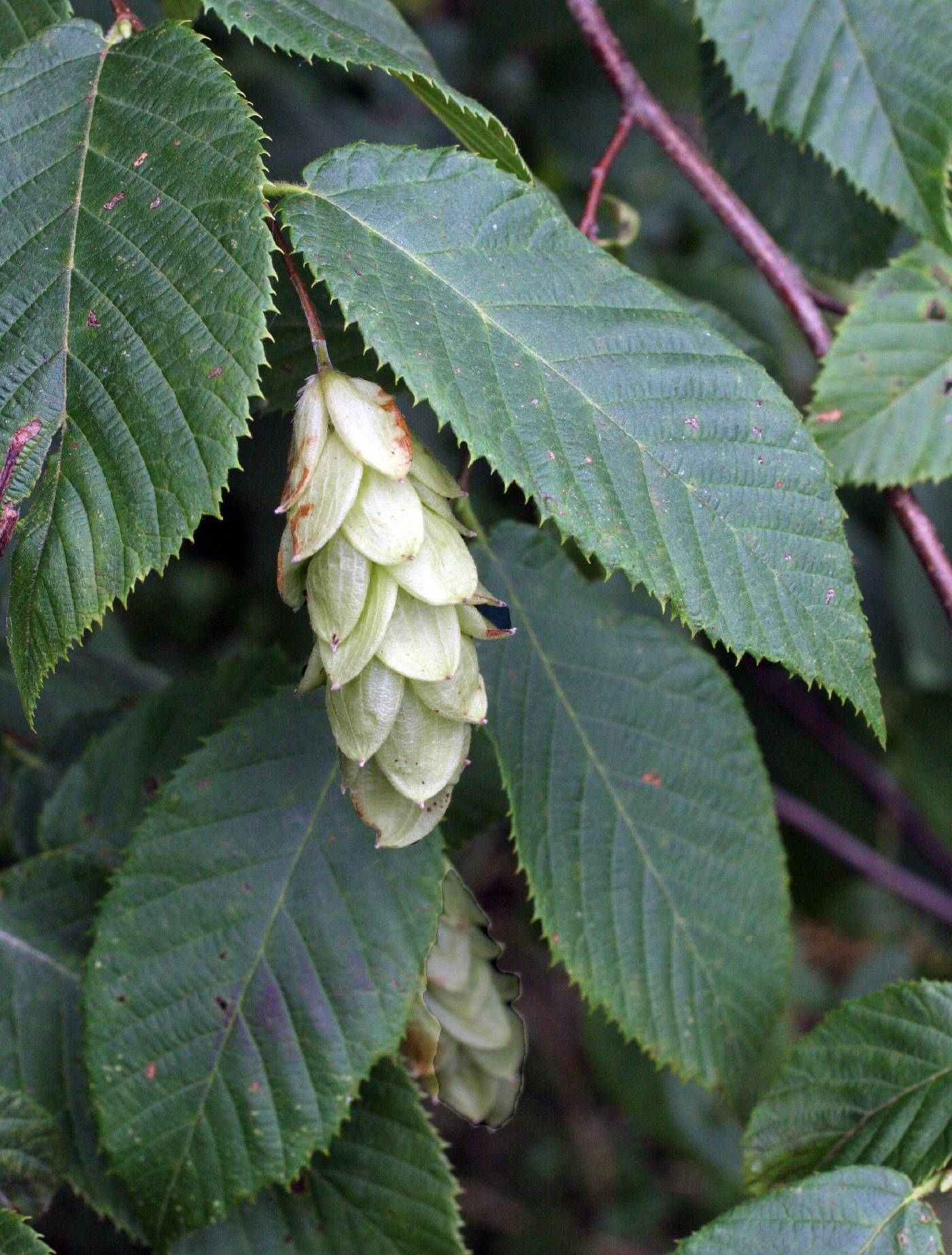
|
Family: Betulaceae |
Trees , 9--18 m; trunks usually 1, branching mostly deliquescent, trunk and branches terete. Bark of trunk and branches brownish gray to light brown, thin, smooth, breaking and shredding into shaggy vertical strips and scales; lenticels generally inconspicuous. Wood nearly white to light brown, very hard and heavy, texture fine. Branches, branchlets, and twigs conspicuously 2-ranked; young twigs differentiated into long and short shoots. Winter buds sessile, ovoid, somewhat laterally compressed, apex acute; scales many, imbricate, longitudinally striate. Leaves on long and short shoots, 2-ranked. Leaf blade narrowly ovate to ovate, elliptic, or obovate with 10 or more pairs of lateral veins, 2.5--13 × 1.5--6 cm, thin, margins doubly serrate to serrulate; surfaces abaxially glabrous to tomentose. Inflorescences: staminate catkins terminal on branches, mostly in small, racemose clusters, formed previous growing season and exposed during winter, expanding with leaves; pistillate catkins proximal to staminate on short, lateral, leafy new growth, solitary, ± erect, elongate, bracts and flowers uncrowded. Staminate flowers in catkins 3 per bract, crowded together on pilose receptacle; stamens 3(--6), short; filaments often divided part way to base; anthers divided into 2 parts, each 1-locular, apex pilose. Pistillate flowers 2 per bract. Infructescences loosely imbricate, strobiloid clusters of closed inflated bracts; clusters pendulous, elongate; bracts deciduous with fruit, inflated, bladderlike, each bract enclosing 1 fruit. Fruits small nutlets, ovoid, longitudinally ribbed, often crowned with persistent sepals and styles. x = 8. In North America Ostrya consists of small trees in the northern temperate deciduous forest zone and in the mountains of southwestern United States and adjacent Mexico. Mexican populations have generally been treated as conspecific with O . virginiana of eastern United States and Canada. They differ in various respects, however, including leaf shape and indumentum; the morphologic variation and phytogeography of the complex as a whole should be carefully examined. Ostrya carpinifolia Scopoli is a common and important forest tree of southern Europe. Ostrya shares many features with Carpinus . The staminate catkins in most species of Ostrya are produced the season before anthesis but, unlike Carpinus , they are exposed during the winter. Dispersal occurs as it does in Carpinus , except that the bracts form closed, bladderlike structures rather than flat wings. The wood of Ostrya is used for fuel, fence posts, and various other purposes. It was formerly utilized for manufacturing items subject to prolonged friction, including sleigh runners, wheel rims, and airplane propellers. Because of its hardness, it has been used for tool handles, mallet heads, and other hard wooden objects.
PLANT: Trees to 18 m tall; trunks usually 1 (often several in ours); wood very hard and heavy; bark brownish gray to light brown, breaking into shaggy vertical strips and scales; lenticels generally inconspicuous; twigs conspicuously 2-ranked, differentiated into long and short shoots; winter buds sessile, longitudinally striate, with many imbricate scales. LEAVES: on long and short shoots, 2-ranked; blades ovate to obovate with 10 or more pairs of lateral veins; margins doubly serrate to serrulate; surfaces abaxially glabrous to tomentose. INFLORESCENCE: staminate catkins pendulous, mostly in small racemose clusters, visible the previous growing season; pistillate catkins terminal on short shoots, pendulous, produced in the current season; fruiting catkins white or tan strobiloid clusters of inflated bracts, each bract dispersed with the enclosed fruit. STAMINATE FLOWERS: 3 per bract; stamens 3-6, the filaments divided, each part bearing an apically pilose anther sac. PISTILLATE FLOWERS: 2 per bract. FRUITS small, ovoid nutlets. x = 8. NOTES: 5 spp.; mostly n temperate zones. (Greek ostryos = scale - referring to scaly catkins). REFERENCES: Brasher, Jeffrey W. 2001. Betulaceae. J. Ariz. - Nev. Acad. Sci. Volume 33(1) Staminate catkins dense, the spirally arranged, depressed-ovate scales each terminating in a sharp point and subtending a cluster of several stamens without perianth; filaments short, divided at the summit, each branch bearing an apically pilose half-anther; pistillate catkins slender, loosely fld, the ovate, hairy bracts caducous, subtending 2 fls each enclosed within an ovoid pouch composed of united bract and bractlets, the cal minute; bracts accrescent and inflated in fr, forming a hops- like strobilus; fr a flattened-ovoid nutlet; trees or tall shrubs with rough, flaky bark, the catkins opening with the lvs in the spring. 10, mainly N. Temp. Gleason, Henry A. & Cronquist, Arthur J. 1991. Manual of vascular plants of northeastern United States and adjacent Canada. lxxv + 910 pp. ©The New York Botanical Garden. All rights reserved. Used by permission. |
This project was made possible in part by the Institute of Museum and Library Services [MG-70-19-0057-19].
Powered by Symbiota



